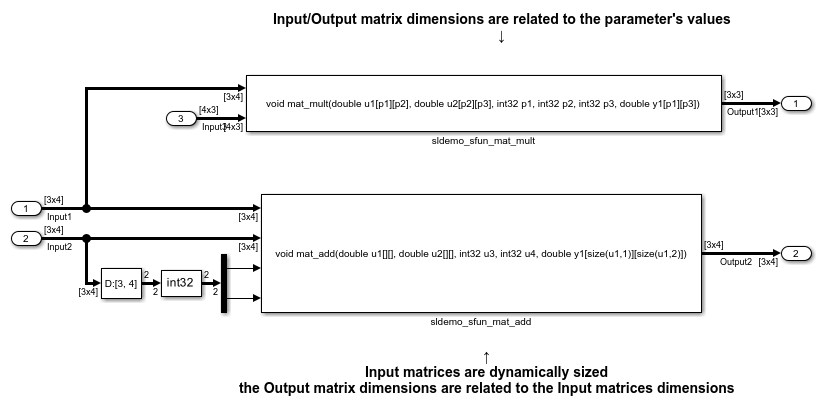레거시 함수 인수에 상속된 신호 차원 사용
이 예제에서는 레거시 코드 툴을 사용하여 상속된 차원을 인수로 사용하는 레거시 C 함수를 통합하는 방법을 보여줍니다.
레거시 코드 툴을 사용하면 다음이 가능합니다.
레거시 함수 사양 제공
시뮬레이션 중에 레거시 코드를 호출하는 데 사용되는 C-MEX S-Function 생성
생성된 S-Function을 시뮬레이션용으로 컴파일 및 빌드
레거시 함수 사양 제공하기
레거시 코드 툴과 함께 제공되는 함수는 특정 데이터 구조체 또는 구조체로 구성된 배열을 인수로 받습니다. 데이터 구조체는 첫 번째 입력값으로 'initialize'를 사용하여 함수 legacy_code()를 호출함으로써 초기화됩니다. 구조체를 초기화한 후에는 통합하려는 레거시 코드에 해당하는 값에 속성을 할당해야 합니다. 이 예제에서 호출하는 레거시 함수의 프로토타입은 다음과 같습니다.
void mat_add(real_T *u1, real_T *u2, int32_T nbRows, int32_T nbCols, real_T *y1)
void mat_mult(real_T *u1, real_T *u2, int32_T nbRows1, int32_T nbCols1, int32_T nbCols2, real_T *y1)
여기서 real_T는 double형에 대한 typedef이고 int32_T는 32비트 정수에 대한 typedef입니다. 레거시 소스 코드는 파일 mat_ops.h 및 mat_ops.c에서 확인할 수 있습니다.
defs = []; % sldemo_sfun_mat_add def = legacy_code('initialize'); def.SFunctionName = 'sldemo_sfun_mat_add'; def.OutputFcnSpec = ['void mat_add(double u1[][], double u2[][], ' ... 'int32 u3, int32 u4, double y1[size(u1,1)][size(u1,2)])']; def.HeaderFiles = {'mat_ops.h'}; def.SourceFiles = {'mat_ops.c'}; def.IncPaths = {'sldemo_lct_src'}; def.SrcPaths = {'sldemo_lct_src'}; defs = [defs; def]; % sldemo_sfun_mat_mult def = legacy_code('initialize'); def.SFunctionName = 'sldemo_sfun_mat_mult'; def.OutputFcnSpec = ['void mat_mult(double u1[p1][p2], double u2[p2][p3], '... 'int32 p1, int32 p2, int32 p3, double y1[p1][p3])']; def.HeaderFiles = {'mat_ops.h'}; def.SourceFiles = {'mat_ops.c'}; def.IncPaths = {'sldemo_lct_src'}; def.SrcPaths = {'sldemo_lct_src'}; defs = [defs; def];
시뮬레이션 중에 사용할 S-Function 생성 및 컴파일하기
함수 legacy_code()는 입력 인수 'defs'로 제공되는 설명에 따라 C-MEX S-Function을 자동으로 생성 및 컴파일하기 위해 첫 번째 입력값을 'generate_for_sim'으로 설정하여 다시 호출됩니다. 이 S-Function은 시뮬레이션에서 레거시 함수를 호출하는 데 사용됩니다. S-Function의 소스 코드는 sldemo_sfun_mat_add.c 및 sldemo_sfun_mat_mult.c 파일에서 확인할 수 있습니다.
legacy_code('generate_for_sim', defs);
### Start Compiling sldemo_sfun_mat_add
mex('-I/tmp/Bdoc25a_2974004_37749/tpd97f16fc/simulink_features-ex63241227/sldemo_lct_src', '-I/tmp/Bdoc25a_2974004_37749/tpd97f16fc/simulink_features-ex63241227', '-c', '-outdir', '/tmp/Bdoc25a_2974004_37749/tp936a32dc_cd2b_48de_a902_fb45c0173eb2', '/tmp/Bdoc25a_2974004_37749/tpd97f16fc/simulink_features-ex63241227/sldemo_lct_src/mat_ops.c')
Building with 'gcc'.
MEX completed successfully.
mex('sldemo_sfun_mat_add.c', '-I/tmp/Bdoc25a_2974004_37749/tpd97f16fc/simulink_features-ex63241227/sldemo_lct_src', '-I/tmp/Bdoc25a_2974004_37749/tpd97f16fc/simulink_features-ex63241227', '/tmp/Bdoc25a_2974004_37749/tp936a32dc_cd2b_48de_a902_fb45c0173eb2/mat_ops.o')
Building with 'gcc'.
MEX completed successfully.
### Finish Compiling sldemo_sfun_mat_add
### Exit
### Start Compiling sldemo_sfun_mat_mult
mex('-I/tmp/Bdoc25a_2974004_37749/tpd97f16fc/simulink_features-ex63241227/sldemo_lct_src', '-I/tmp/Bdoc25a_2974004_37749/tpd97f16fc/simulink_features-ex63241227', '-c', '-outdir', '/tmp/Bdoc25a_2974004_37749/tp619757cd_50c9_4a41_8e4e_be2f1afeec65', '/tmp/Bdoc25a_2974004_37749/tpd97f16fc/simulink_features-ex63241227/sldemo_lct_src/mat_ops.c')
Building with 'gcc'.
MEX completed successfully.
mex('sldemo_sfun_mat_mult.c', '-I/tmp/Bdoc25a_2974004_37749/tpd97f16fc/simulink_features-ex63241227/sldemo_lct_src', '-I/tmp/Bdoc25a_2974004_37749/tpd97f16fc/simulink_features-ex63241227', '/tmp/Bdoc25a_2974004_37749/tp619757cd_50c9_4a41_8e4e_be2f1afeec65/mat_ops.o')
Building with 'gcc'.
MEX completed successfully.
### Finish Compiling sldemo_sfun_mat_mult
### Exit
코드 생성을 위해 rtwmakecfg.m 파일 생성하기
TLC 블록 파일이 생성되면, rtwmakecfg.m 파일을 생성하여 Simulink® Coder™를 통한 코드 생성을 지원하기 위해 첫 번째 입력값을 'rtwmakecfg_generate'로 설정하여 함수 legacy_code()를 다시 호출할 수 있습니다. S-Function에 필요한 소스 및 헤더 파일이 S-Function과 동일한 디렉터리에 있지 않아 코드 생성 중에 생성된 makefile에 이러한 종속성을 추가하려면 rtwmakecfg.m 파일을 생성하십시오.
참고: 이 단계는 가속화된 모드에서 모델을 시뮬레이션해야 하는 경우에만 수행하십시오.
legacy_code('rtwmakecfg_generate', def);
생성된 S-Function의 호출을 위해 마스크 처리된 S-Function 블록 생성하기
C-MEX S-Function 소스가 컴파일되면, 해당 S-Function을 호출하도록 구성된 마스크 처리된 S-Function 블록을 생성하기 위해 첫 번째 입력값을 'slblock_generate'로 설정하여 함수 legacy_code()를 다시 호출할 수 있습니다. 블록은 새 모델에 배치되며 기존 모델로 복사할 수 있습니다.
% legacy_code('slblock_generate', defs);
레거시 코드 통합하기
모델 sldemo_lct_inherit_dims는 레거시 코드와의 통합을 보여줍니다. TestMatOps 서브시스템은 이전 출력값을 저장하는 데 단위 지연을 사용하며, 레거시 C 함수를 호출하기 위한 하네스로 사용됩니다.
open_system('sldemo_lct_inherit_dims') open_system('sldemo_lct_inherit_dims/TestMatOps') sim('sldemo_lct_inherit_dims');
